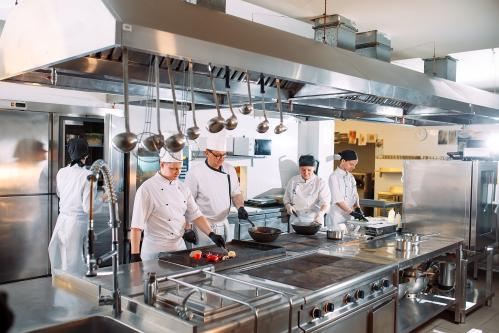This blog is a summary of a November 10, 2022 discussion on Twitter Spaces. Quotes have been edited for clarity. You can listen to the full conversation on Twitter here.
After several months of higher-than-expected growth, the Consumer Price Index rose by a less-than-expected 0.4% in October on a seasonally adjusted basis according to the latest Bureau of Labor Statistics release, the same increase as in September. Core CPI (that is, excluding volatile food and energy) rose 0.3% after a 0.6% rise in September. Overall, year-over-year inflation was down to 7.7%, the lowest it has been since January 2022.
On the morning of the release, Brookings once again convened Brookings’ David Wessel and Wendy Edelberg and Justin Wolfers of the University of Michigan to discuss the report. You can read key takeaways from their discussion below, and listen to the full discussion on Twitter here.
A sigh of relief
Although the October data represents only one month of data after a series of disappointing reports, cautioned Wolfers, it was a very hopeful report: “I am still unbelievably excited by seeing this,” he said. Inflation is obviously still elevated and will remain so, he continued, and it will continue to be a concern for policymakers and economists, but it is starting to look like it will return to levels that aren’t as much of a concern for families within the next year. “We may have seen not only the peak of inflation behind us, but glimmers of excitement that the crisis, we can see how and why and when it might end,” said Wolfers. Edelberg agreed with cautious optimism, saying she was relieved to see a reduction in core goods costs that reflected slowing demand, a result, at least in part, of actions by the Federal Reserve: “I think core goods would be just the most obvious place to see it and it worried me that we weren’t seeing it. We saw it in October. That is good news. But this is the bare minimum for what we need to see to get inflation under control. So good news, but I am still holding my breath.”
“We may have seen not only the peak of inflation behind us, but glimmers of excitement that the crisis, we can see how and why and when it might end.”
Goods prices down, services (especially housing) still up
The prices of services – in particular the cost of shelter – continued to rise more than the cost of goods in October. “The bad news is that shelter inflation is very slow to move,” said Edelberg, “And so the Fed’s going have to be a little patient. We’re all going to be a little patient as we look at these numbers. But I think that we have lots of indications that that will come down.” Shelter inflation measures have a built-in lag, explained Wolfers. “We can predict what’s happening to shelter pretty readily, which is that’s going to be a decreasing source of inflation over the next year, year and a half.” Meanwhile, other types of services spending, from concerts to gym memberships, are lower than would’ve been expected pre-pandemic, said Edelberg, which was a hopeful sign for the overall inflationary picture.
Corporate greed isn’t the big problem – demand is.
With many companies posting high profits lately, many have argued (including prominent senators) that corporate greed is one driver of inflation. Edelberg and Wolfers explained that while corporations are always eager to raise prices and maximize profits, this doesn’t explain the recent unwelcome increase in inflation. “It is surely true as it’s always true that businesses are charging the highest prices that the market will bear and they are working hard to maximize their profits,” said Edelberg. High demand for goods, along with various pandemic-related supply issues, have thus led to higher prices she explained. But this dynamic holds true even outside of inflationary periods said Wolfers. “You’re allowed to be mad at them as long as you’re just as mad at them when we have high inflation as when we have low inflation,” he said. Borrowing a metaphor from Harvard economist Jason Furman, Wolfers said, “Yes, you can blame inflation on corporate greed in the same way you can blame a plane crash on gravity. At a literal level it’s true … but it kind of seems the wrong diagnosis.”
“People care about where things are headed. And I think that there’s a lot of uncertainty and anxiety about where things are headed.”
Did inflation affect the election after all?
The economy was the top issue for many voters going into the election, and many pundits expected that to hurt Democratic candidates. Wessel asked Wolfers and Edelberg whether they believed that the better-than-expected results for Democrats confounded those predictions, which Wolfers argued were just over-simplified. “Yes, we’ve got high inflation,” he said, “but a whole lot of the rest of the economy is doing a whole heck of a lot better even than we’ve done in the last 50 years or than we’ve done in recent history. It’s not a an ‘all good news’ or ‘all bad news’ economy, and I think the narratives are just a little too simple.” Edelberg added that where the economy likely did have an effect is not just in the current state of the economy but attitudes about where it’s headed. “People don’t just care about levels, people care about trajectory. People care about where things are headed. And I think that there’s a lot of uncertainty and anxiety about where things are headed,” she said.
The Brookings Institution is financed through the support of a diverse array of foundations, corporations, governments, individuals, as well as an endowment. A list of donors can be found in our annual reports published online here. The findings, interpretations, and conclusions in this report are solely those of its author(s) and are not influenced by any donation.






Commentary
4 key takeaways from the November CPI report
November 10, 2022